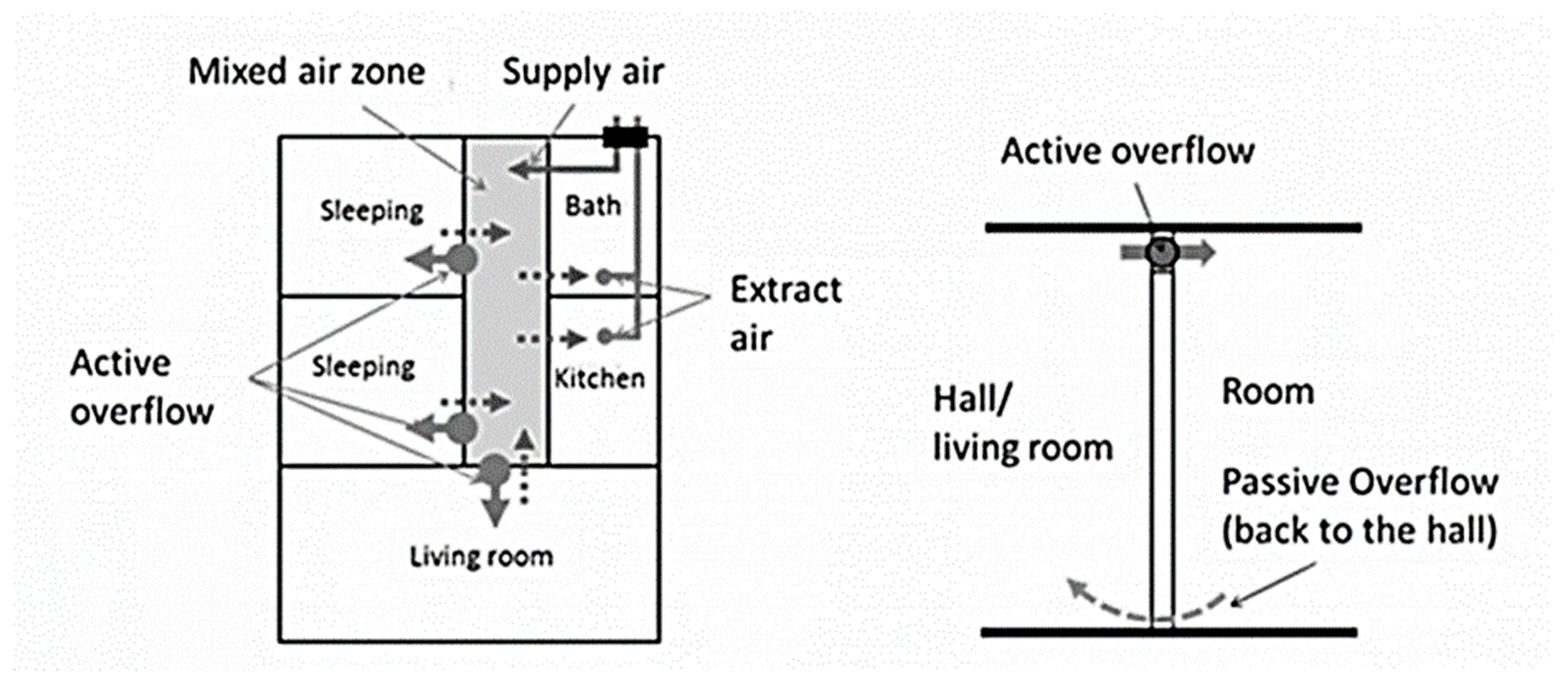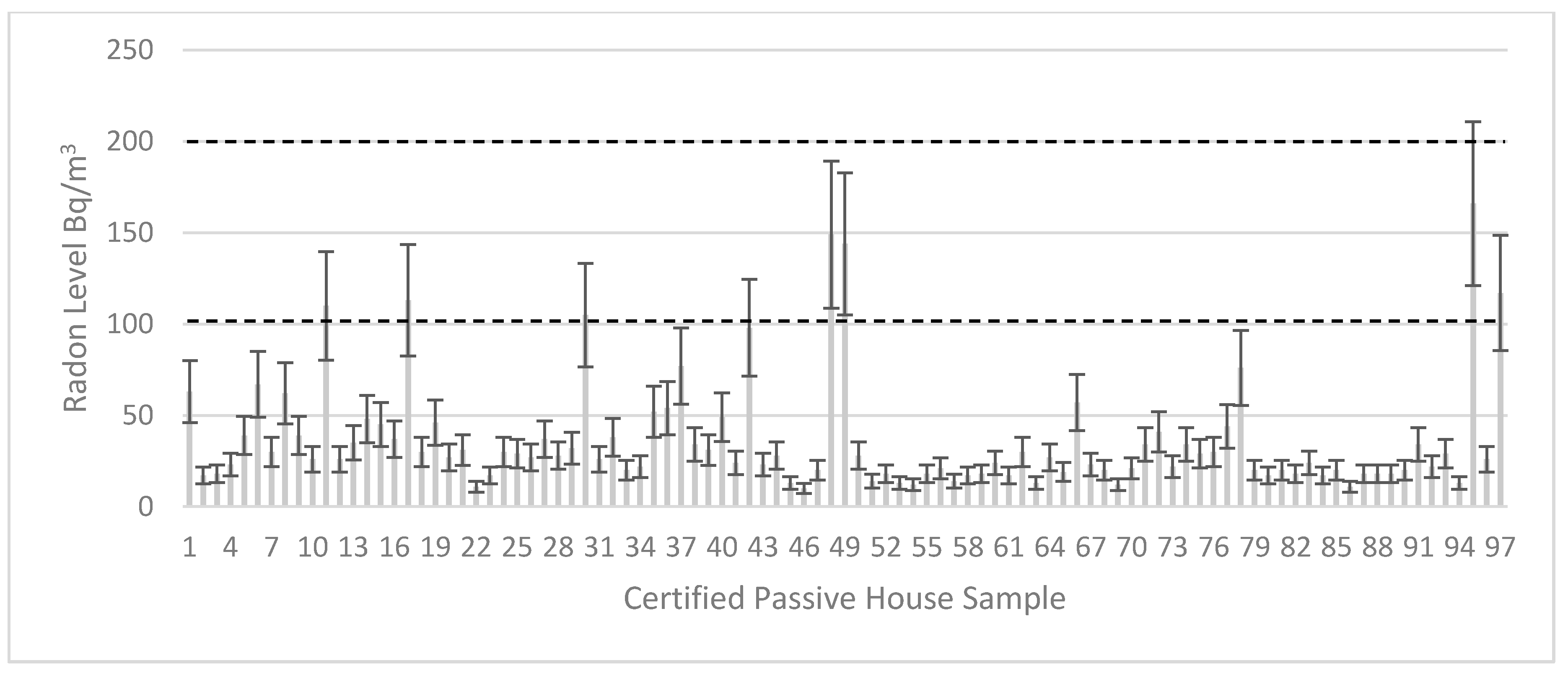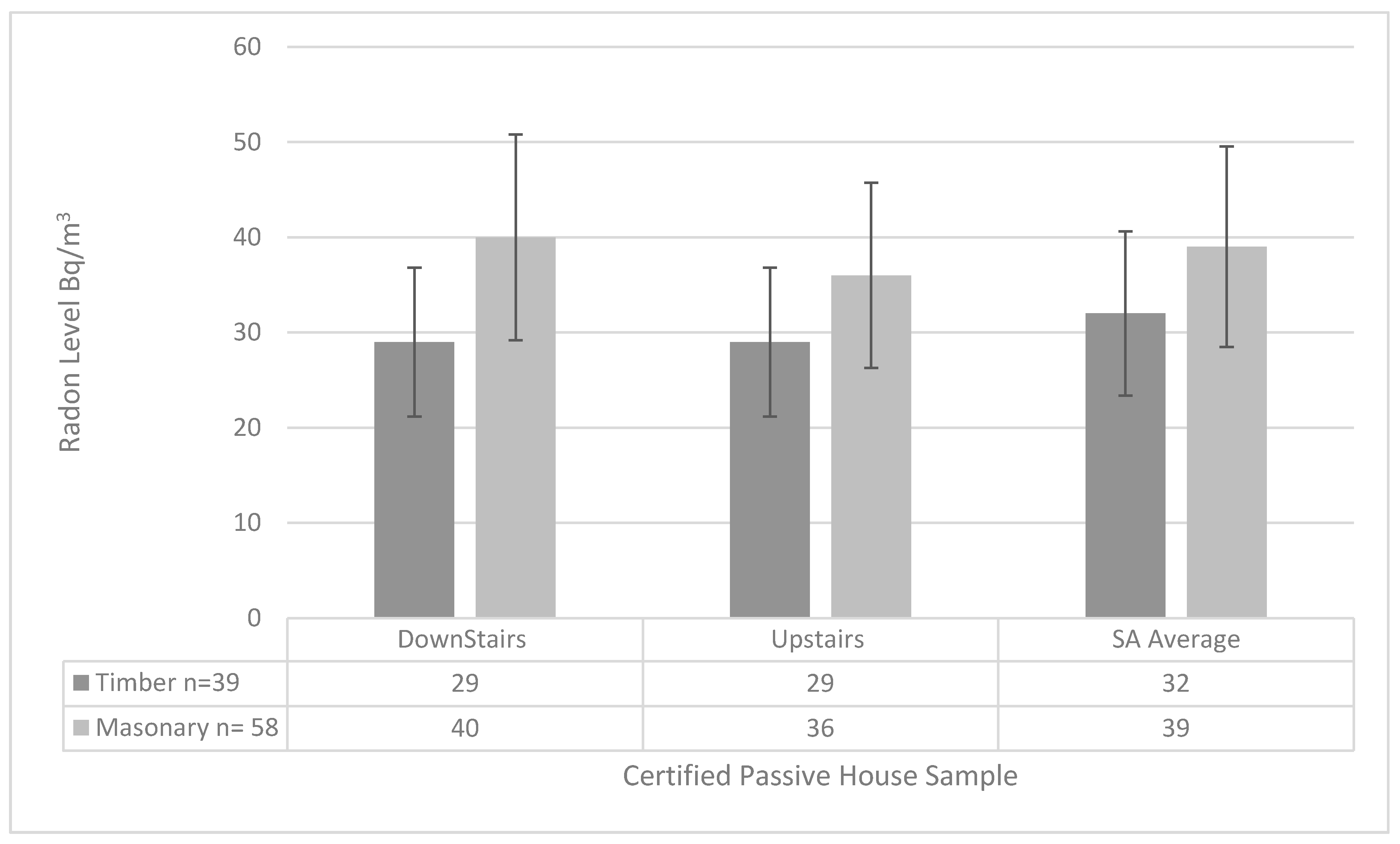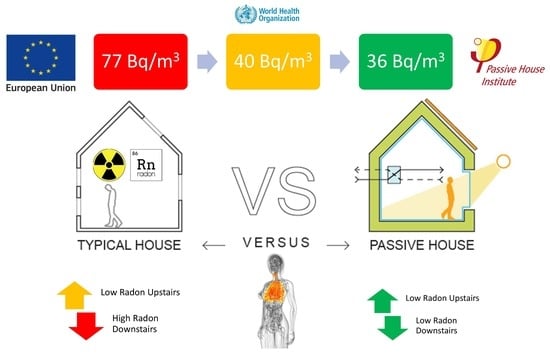An Investigation into Indoor Radon Concentrations in Certified Passive House Homes
Abstract
1. Introduction
1.1. Background
1.2. Motivation for this Study
1.3. Study Objectives
- (a)
- Evaluating the findings against the established reference levels and the national average;
- (b)
- Comparing radon distribution levels between upstairs and downstairs;
- (c)
- Identifying the influence of construction materials on corresponding radon concentrations;
- (d)
- Determining the indoor radon concentrations of the Passive House Retrofit standard (EnerPHit) sample;
- (e)
- Carrying out comparative case studies analysis of indoor radon concentrations in a high-risk radon area.
1.4. Review of Current Literature
2. Materials and Methods
3. Results
3.1. Radon Levels against National Average
3.2. Radon Distribution
3.3. Radon from Building Materials
3.4. Comparative Case Studies
4. Discussion
- (a)
- The results of this study are broadly in agreement with the small amount of similar research carried out in other EU Countries. The Passive House sample presented an average 36 Bq/m3. This falls below all other comparable reference levels and is aligned with the “as low as reasonably achievable” (ALARA) principle. There are two likely causes for the reduced concentrations: The role of airtightness coupled with a properly installed and commissioned balanced mechanical ventilation system facilitate lower indoor radon concentrations. The role of passive house certification also provides level of oversight to ensure the design metrics are upheld with respect to airtightness and ventilation rates and balancing of the system.
- (b)
- The radon distribution results are interesting in that they presented with a much lower ratio between upstairs and downstairs. The observed correlation between upstairs and downstairs might be explained in this way: The passive house standard employs the crossflow principle for mechanical ventilation design which allows circulation and air transfer throughout the building thus redistributing radon concentrations. These results are in sharp contrast to the limited available research on radon distribution between floors. In the Passive House certification framework, the air transfer strategy is checked to ensure certification.
- (c)
- Another possible explanation for this more uniform distribution ratio is the role of floor plan configuration; under the ventilation design methodology in passive house, there will often be more extract than supply on the ground floor and indeed the opposite on the first floor. This is primarily because all bedrooms are supply and in a typical two storey dwelling the larger percentage of bedrooms are located upstairs. This suggestion will also contribute to a lower distribution ratio between floors.
- (d)
- The comparison of the construction materials did result in two differentials. The timber sample yielded a lower radon concentration of 32 Bq/m3 compared to 38 Bq/m3 in the masonry sample. There was also a difference in radon distribution both floors had an average of 29 Bq/m3 in the timber sample compared to 40 Bq/m3 on the ground floor and 36 Bq/m3 on the first floor in the masonry sample. It is reported in previous literature that masonry construction materials will emit and contribute to the background radon in a building. The results here would indicate the same; however, this would require further investigation.
- (e)
- The results from the EnerPHit standard sample indicated higher radon levels 72 Bq/m3 than the rest of the passive house sample 36 Bq/m3; however, this was still a lower level than the comparison sample measured in this study 88 Bq/m3 and the figures recorded in the last national radon survey 77 Bq/m3. This suggests that the passive house standard for retrofit will also act as an effective control for radon. It must be noted, however, that this must be treated with caution as the number of EnerPHit homes measured (five) is very low.
5. Conclusions
5.1. Summary of Research
- (a)
- The monitored radon levels have been taken on 97 certified passive house buildings, and these results have been evaluated against the established reference levels and the national average.
- (b)
- The radon distribution levels between upstairs and downstairs were analysed in in the 97 certified passive house buildings, which are all two storey domestic dwellings.
- (c)
- The type of construction was identified for all buildings in the sample, and the influence of the construction materials was compared.
- (d)
- Ten homes within the sample were identified as being in high risk radon areas and had the distinction of having an adjacent dwelling. The results of the monitoring of indoor radon concentrations were compared between both homes at each of the ten locations.
- (e)
- The sample of certified buildings included five Passive House Retrofit (EnerPHit) homes, and the radon levels for these homes were also compared.
5.2. Main Findings
- (a)
- The overall monitoring results support the hypothesis outlined at the start of this paper that certified Passive House buildings perform better in respect to indoor radon concentrations 36 Bq/m3 compared to conventional homes 88 Bq/m3 given less airtightness and no MVHR systems. The case study dwellings located in the geogenic high-risk areas, which presented elevated concentrations in the standard homes compared directly with the ten passive house buildings, further consolidate the narrative.
- (b)
- The radon distribution results support the opinion that the passive house framework for quality assurance of the design, installation and commissioning delivers design performance in MVHR systems. This will result in more extract on the ground floor thus reducing the ground floor radon level and lowering the distribution gap.
- (c)
- The findings on the relationship between construction materials and radon concentrations are not statistically significant to make claims about background radon emissions.
- (d)
- Finally, the EnerPHit sample presents lower indoor radon concentrations. It is acknowledged that the number of houses investigated was very small, and the results should be treated with caution; however, they correlate with results in similar pilot studies.
5.3. Implications for Future Practise
- (a)
- They illustrate the value of having a clear methodology of quality assurance (integral to the passive house process).
- (b)
- Passive House exhibits better radon performance, which may be ascribed to the combination of reduced air infiltration combined with MVHR.
- (c)
- They highlight the significance of ensuring the MVHR system is balanced at the commission stage, so the house is at a slight positive pressure, i.e., the slight positive pressure (<3%) will reduce the risk of radon ingress.
5.4. Future Work
- (a)
- Modelling or simulation studies of the crossflow principle and the relationship with MVHR airflows.
- (b)
- Investigations into the radon concentrations emanating from construction materials particularly with the recent EU Directive mandating reference levels for gamma radiation emission from building materials.
- (c)
- In addition, more work could be carried out on the pressure differentials produced from the various arrays of mechanical ventilation systems being employed in European housing under the EBPD.
- (d)
- Finally, a replication of this work could be carried out on a larger sample of passive house EnerPHit projects, and this study is replicable and scalable for different regions with passive house growth such as North America and Canada where radon is a prevalent issue.
Author Contributions
Funding
Acknowledgments
Conflicts of Interest
References
- BBC News. UK Parliament Declares Climate Change Emergency. BBC News. 2019. Available online: https://www.bbc.com/news/uk-politics-48126677 (accessed on 9 June 2020).
- UN. The Paris Agreement-Main Page; UN: Paris, France, 2016.
- IPCC. Global Warming of 1.5 °C; IPCC: Geneva, Switzerland, 2018.
- IPCC. Fourth Assessment Report (AR4): Mitigation of Climate Change; Working Group III; IPCC: Geneva, Switzerland, 2007. [CrossRef]
- UNEP. The Emissions Gap Report 2017-A UN Environment Synthesis Report; UNEP: Geneva, Switzerland, 2017; ISBN 978-92-9253-062-4. [Google Scholar]
- Council of the European Union. Directive 2010/31/EU of the European Parliament and of the Council of 19 May 2010 on the Energy Performance of Buildings. Off. J. Eur. Union 2010, 153, 13–35. [Google Scholar]
- CCC. Net Zero: The UK’s Contribution to Stopping Global Warming; Committee on Climate Change: London, UK, 2019. [Google Scholar]
- Committee on Climate Change. UK Housing: Fit for the Future; Committee on Climate Change: London, UK, 2019. [Google Scholar]
- Colclough, S.; Mernagh, J.; Sinnott, D.; Hewitt, N.J.; Griffiths, P. The Cost of Building to the Nearly-Zero Energy Building Standard: A Financial Case Study. 2019. Available online: https://doi.org/10.1007/978-3-319-94595-8_7 (accessed on 9 June 2020).
- Foster, J.; Sharpe, T.; Poston, A.; Morgan, C.; Musau, F. Scottish Passive House: Insights into Environmental Conditions in Monitored Passive Houses. Sustainability 2016, 8, 3390. [Google Scholar] [CrossRef]
- Uhling, W.-R. Radon pollution in passive house. In 14th Passive House Conferance 2010; Feist, W., Ed.; Passive House Institute: Dresden, Germany, 2010; pp. 367–372. [Google Scholar]
- Ringer, W.; Gräser, J.; Arvela, H.; Holmgren, O.; Collignan, B.; Scientifique, C.; Fourier, J.; Hères, M. The Effect of New Building Concepts on Indoor Radon; Austrian Agency for Health and Food Safety (AGES): Linz, Austria, May 2012; pp. 13–18. [Google Scholar]
- Poffijn, A.; Tonet, O.; Dehandschutter, B.; Roger, M.; Bouland, C. A Pilot Study on the Air Quality in Passive Houses with Particular Attention to Radon, Proceedings of the International AARST Symposium; The American Association of Radon Scientists and Technologists (AARST): Hendersonville, NC, USA, 2012; pp. 107–112. [Google Scholar]
- Passive House Institute. Certified Passive House-Certification Criteria for Residential Passive House Buildings; Passive House Institute: Darmstadt, Germany, 2013. [Google Scholar]
- Cotterell, J. The PassivHaus Handbook. In The Passivhaus Handbook: A Practical Guide to Constructing and Retrofitting Buildings for Ultra-Low Energy Performance (Sustainable Building); Green Books: Cambridge, UK, 2012; Volume 1, p. 189. [Google Scholar]
- Schnieders, J.; Hermelink, A. CEPHEUS Results: Measurements and Occupants’ Satisfaction Provide Evidence for Passive Houses Being an Option for Sustainable Building. Energy Policy 2006, 34, 151–171. [Google Scholar] [CrossRef]
- Passive House Institute. Criteria for the Passive House, EnerPHit and PHI Low Energy Building Standard; Passive House Institute: Darmstadt, Germany, 2016. [Google Scholar]
- ISO (International Organization for Standardization). ISO 7730: Ergonomics of the Thermal Environment Analytical Determination and Interpretation of Thermal Comfort Using Calculation of the PMV and PPD Indices and Local Thermal Comfort Criteria. Management 2005, 52. [Google Scholar] [CrossRef]
- Passipedia. Passipedia—The Passive House Resource. Available online: https://www.passipedia.org/ (accessed on 9 June 2020).
- Font Guiteras, L. Radon Generation, Entry and Accumulation Indoors. Ph.D. Thesis, University of Barcelona, Barcelona, Spain, 2008. [Google Scholar]
- Rosemeier, K. Healthy and Affordable Housing in New Zealand: The Role of Ventilation. Ph.D. Thesis, University of Auckland, Auckland, New Zealand, 2014. [Google Scholar]
- Rojas, G.; Pfluger, R.; Feist, W. Cascade Ventilation-Air Exchange Efficiency in Living Rooms without Separate Supply Air. Energy Build. 2015. [Google Scholar] [CrossRef]
- Dempsey, S.; Lyons, S.; Nolan, A. High Radon Areas and Lung Cancer Prevalence: Evidence from Ireland. J. Environ. Radioact. 2018. [Google Scholar] [CrossRef] [PubMed]
- WHO. Indoor Radon a Public Health Perspective. Public Health Perspect. 2009. [Google Scholar] [CrossRef]
- Milner, J.; Shrubsole, C.; Das, P.; Jones, B.; Ridley, I.; Chalabi, Z.; Hamilton, I.; Armstrong, B.; Davies, M.; Wilkinson, P. Home Energy Efficiency and Radon Related Risk of Lung Cancer: Modelling Study. BMJ 2014, 348, 1–12. [Google Scholar] [CrossRef] [PubMed]
- Dowdall, A.; Murphy, P.; Pollard, D.; Fenton, D. Update of Ireland’s National Average Indoor Radon Concentration-Application of a New Survey Protocol. J. Environ. Radioact. 2017. [Google Scholar] [CrossRef] [PubMed]
- Klepeis, N.E.; Nelson, W.C.; Ott, W.R.; Robinson, J.P.; Tsang, A.M.; Switzer, P.; Behar, J.V.; Hern, S.C.; Engelmann, W.H. The National Human Activity Pattern Survey (NHAPS): A Resource for Assessing Exposure to Environmental Pollutants. J. Expo. Anal. Environ. Epidemiol. 2001. [Google Scholar] [CrossRef] [PubMed]
- Health Protection Agency. Radon and Public Health RCE 11; The Centre for Radiation, Chemical and Environmental Hazards: Oxon, UK, 2009; p. 86. [Google Scholar]
- Fornalski, K.W.; Adams, R.; Allison, W.; Corrice, L.E.; Cuttler, J.M.; Davey, C.; Dobrzyński, L.; Esposito, V.J.; Feinendegen, L.E.; Gomez, L.S.; et al. The Assumption of Radon-Induced Cancer Risk. Cancer Causes Control. 2015. [Google Scholar] [CrossRef] [PubMed]
- Scott, B.R. Epidemiologic Studies Cannot Reveal the True Shape of the Dose–Response Relationship for Radon-Induced Lung Cancer. Dose-Response 2019. [Google Scholar] [CrossRef]
- Scott, B.R. Residential Radon Appears to Prevent Lung Cancer. Dose-Response 2011. [Google Scholar] [CrossRef]
- Health Protection Agency. Limitation of Human Exposure to Radon, Advice from the Health Protection Agency; Health Protection Agency: Chilton, UK, 2010. [Google Scholar]
- Denman, A.R.; Groves-Kirkby, C.J.; Groves-Kirkby, N.P.; Crockett, R.G.M.; Phillips, P.S.; Woolridge, A.C. Factors Influencing Upstairs and Downstairs Radon Levels in Two-Storey Dwellings. 2006 IRPA Paris 2006, 81, 1–13. [Google Scholar]
- Woolley, T. New Homes and Wellbeing: Building Materials, Health and Indoor Air Quality New Book Raises Issue about Hazardous Materials in Buildings; Routledge: London, UK, 2016; ISBN 9781138934474. [Google Scholar]
- Collins, M.; Dempsey, S. Residential Energy efficiency retrofitting: Potential unintended consequences. J. Environ. Plan. Manag. 2019, 62, 2010–2025. [Google Scholar] [CrossRef]
- Hanley, O.; Gutiérrez-Villanueva, J.L.; Currivan, L.; Pollard, D. Assessment of the Uncertainties in the Radiological Protection Institute of Ireland (RPII) Radon Measurements Service. J. Environ. Radioact. 2008, 99, 1578–1582. [Google Scholar] [CrossRef] [PubMed]
- Public Health Engalnd. UK National Radon Action Plan. About Public Health England; Public Health England: Chilton, UK, 2018. [Google Scholar]






| Metric | EPA 2015 NRS | Comparison Sample | PH Sample |
|---|---|---|---|
| Number of homes measured | 649 | 25 | 97 |
| No. of homes > 200 Bq/m3 | 8% | 8% | 0% |
| No. of homes > 100 Bq/m3 | 25% | 16% | 7% |
| Minimum concentration (Bq/m3) | 14 | 21 | 10 |
| Maximum concentration (Bq/m3) | 1393 | 598 | 149 |
| SAA 1 average for Sample | 77 | 88 | 36 |
| Study | No of Samples | Mean Ratio | Median Ratio | Standard Deviation |
|---|---|---|---|---|
| National Radon Study | 344 | 0.79 | 0.74 | 0.37 |
| Passive House Study | 97 | 1.03 | 0.92 | 0.56 |
© 2020 by the authors. Licensee MDPI, Basel, Switzerland. This article is an open access article distributed under the terms and conditions of the Creative Commons Attribution (CC BY) license (http://creativecommons.org/licenses/by/4.0/).
Share and Cite
Mc Carron, B.; Meng, X.; Colclough, S. An Investigation into Indoor Radon Concentrations in Certified Passive House Homes. Int. J. Environ. Res. Public Health 2020, 17, 4149. https://doi.org/10.3390/ijerph17114149
Mc Carron B, Meng X, Colclough S. An Investigation into Indoor Radon Concentrations in Certified Passive House Homes. International Journal of Environmental Research and Public Health. 2020; 17(11):4149. https://doi.org/10.3390/ijerph17114149
Chicago/Turabian StyleMc Carron, Barry, Xianhai Meng, and Shane Colclough. 2020. "An Investigation into Indoor Radon Concentrations in Certified Passive House Homes" International Journal of Environmental Research and Public Health 17, no. 11: 4149. https://doi.org/10.3390/ijerph17114149
APA StyleMc Carron, B., Meng, X., & Colclough, S. (2020). An Investigation into Indoor Radon Concentrations in Certified Passive House Homes. International Journal of Environmental Research and Public Health, 17(11), 4149. https://doi.org/10.3390/ijerph17114149







